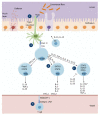Genetic update on inflammatory factors in ulcerative colitis: Review of the current literature
- PMID: 25133031
- PMCID: PMC4133528
- DOI: 10.4291/wjgp.v5.i3.304
Genetic update on inflammatory factors in ulcerative colitis: Review of the current literature
Abstract
Ulcerative colitis (UC) is one of the main types of inflammatory bowel disease, which is caused by dysregulated immune responses in genetically predisposed individuals. Several genetic factors, including interleukin and interleukin receptor gene polymorphisms and other inflammation-related genes play central role in mediating and modulating the inflammation in the human body, thereby these can be the main cause of development of the disease. It is clear these data are very important for understanding the base of the disease, especially in terms of clinical utility and validity, but summarized literature is exiguous for challenge health specialist that can used in the clinical practice nowadays. This review summarizes the current literature on inflammation-related genetic polymorphisms which are associated with UC. We performed an electronic search of Pubmed Database among publications of the last 10 years, using the following medical subject heading terms: UC, ulcerative colitis, inflammation, genes, polymorphisms, and susceptibility.
Keywords: Genes; Inflammatory factors; Polymorphisms; Susceptibility; Ulcerative colitis.
Figures

Similar articles
-
Novel genetic association between ulcerative colitis and the anti-inflammatory cytokine interleukin-1 receptor antagonist.Gastroenterology. 1994 Mar;106(3):637-42. doi: 10.1016/0016-5085(94)90696-3. Gastroenterology. 1994. PMID: 8119534
-
KFL2 participates in the development of ulcerative colitis through inhibiting inflammation via regulating cytokines.Eur Rev Med Pharmacol Sci. 2018 Aug;22(15):4941-4948. doi: 10.26355/eurrev_201808_15633. Eur Rev Med Pharmacol Sci. 2018. PMID: 30070340
-
Interleukin-17 SNPs and serum levels increase ulcerative colitis risk: a meta-analysis.World J Gastroenterol. 2014 Nov 14;20(42):15899-909. doi: 10.3748/wjg.v20.i42.15899. World J Gastroenterol. 2014. PMID: 25400476 Free PMC article. Review.
-
The Polymorphisms of Interleukin-12B Gene and Susceptibility to Inflammatory Bowel Diseases: A Meta-analysis and Trial Sequential Analysis.Immunol Invest. 2021 Nov;50(8):987-1006. doi: 10.1080/08820139.2020.1863981. Epub 2021 Jan 4. Immunol Invest. 2021. PMID: 33390082
-
The Role of Propionibacterium acnes in the Pathogenesis of Sarcoidosis and Ulcerative Colitis: How This Connection May Inspire Novel Management of These Conditions.Cureus. 2020 Oct 5;12(10):e10812. doi: 10.7759/cureus.10812. Cureus. 2020. PMID: 33173621 Free PMC article. Review.
Cited by
-
Curcumin alleviates experimental colitis via a potential mechanism involving memory B cells and Bcl-6-Syk-BLNK signaling.World J Gastroenterol. 2022 Oct 28;28(40):5865-5880. doi: 10.3748/wjg.v28.i40.5865. World J Gastroenterol. 2022. PMID: 36353208 Free PMC article.
-
Evidence for the butyrate metabolism as key pathway improving ulcerative colitis in both pediatric and adult patients.Bioengineered. 2021 Dec;12(1):8309-8324. doi: 10.1080/21655979.2021.1985815. Bioengineered. 2021. PMID: 34592880 Free PMC article.
-
Molecular analyses of ADAMTS-1, -4, -5, and IL-17 a cytokine relationship in patients with ulcerative colitis.BMC Gastroenterol. 2023 Oct 5;23(1):345. doi: 10.1186/s12876-023-02985-z. BMC Gastroenterol. 2023. PMID: 37798683 Free PMC article.
-
Pharmacogenetic Effect of Thiopurine Methyl Transferase (TPMT) Gene Expression and Serum TNF on the Imuran Response in Ulcerative Colitis (UC) Iraqi Patients.Rep Biochem Mol Biol. 2023 Oct;12(3):438-447. doi: 10.61186/rbmb.12.3.438. Rep Biochem Mol Biol. 2023. PMID: 38618257 Free PMC article.
-
Detection of QTL controlling feed efficiency and excretion in chickens fed a wheat-based diet.Genet Sel Evol. 2015 Sep 25;47:74. doi: 10.1186/s12711-015-0156-y. Genet Sel Evol. 2015. PMID: 26407557 Free PMC article.
References
-
- Podolsky DK. Inflammatory bowel disease. N Engl J Med. 2002;347:417–429. - PubMed
-
- Molodecky NA, Soon IS, Rabi DM, Ghali WA, Ferris M, Chernoff G, Benchimol EI, Panaccione R, Ghosh S, Barkema HW, et al. Increasing incidence and prevalence of the inflammatory bowel diseases with time, based on systematic review. Gastroenterology. 2012;142:46–54.e42; quiz e30. - PubMed
-
- Loftus EV. Clinical epidemiology of inflammatory bowel disease: Incidence, prevalence, and environmental influences. Gastroenterology. 2004;126:1504–1517. - PubMed
-
- Silverberg MS, Satsangi J, Ahmad T, Arnott ID, Bernstein CN, Brant SR, Caprilli R, Colombel JF, Gasche C, Geboes K, et al. Toward an integrated clinical, molecular and serological classification of inflammatory bowel disease: report of a Working Party of the 2005 Montreal World Congress of Gastroenterology. Can J Gastroenterol. 2005;19 Suppl A:5A–36A. - PubMed
-
- Van Limbergen J, Russell RK, Nimmo ER, Ho GT, Arnott ID, Wilson DC, Satsangi J. Genetics of the innate immune response in inflammatory bowel disease. Inflamm Bowel Dis. 2007;13:338–355. - PubMed
Publication types
LinkOut - more resources
Full Text Sources
Other Literature Sources

